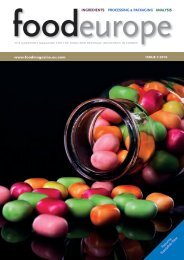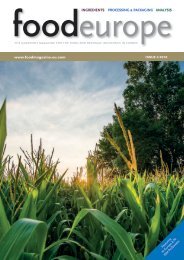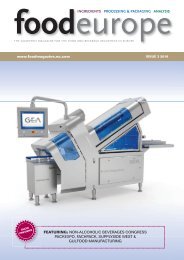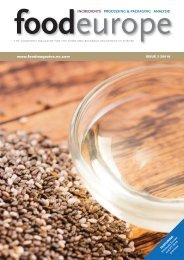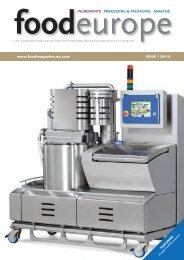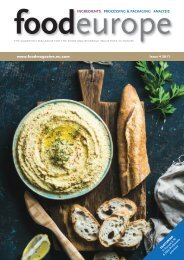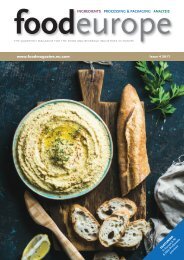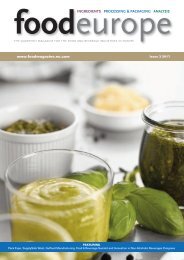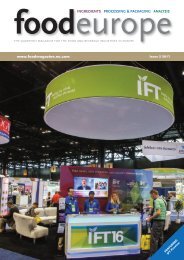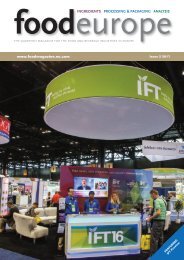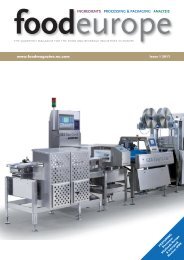issue 1 2017
Issue 1 2017 of FoodEurope Magazine
Issue 1 2017 of FoodEurope Magazine
You also want an ePaper? Increase the reach of your titles
YUMPU automatically turns print PDFs into web optimized ePapers that Google loves.
ingredients 25<br />
despite the fact that more and<br />
more consumers are aware of the<br />
relationship between dietary fibre<br />
and a positive impact on health.<br />
For instance, according to a report<br />
from the American Society for<br />
Nutrition, 1 90% of US adults and<br />
children fall short of meeting their<br />
daily fibre recommendations. In<br />
Europe, it seems that the situation<br />
is not that much better. Southern<br />
countries such as Italy,<br />
France and Spain are<br />
well known for their<br />
traditional white<br />
bread specialties.<br />
And even though<br />
Germany has a<br />
diverse and<br />
distinctive bread<br />
culture, the share<br />
of whole grain<br />
breads in the<br />
overall market is just<br />
10%.<br />
Scandinavians, on the other<br />
hand, are something of a role<br />
model when it comes to whole<br />
grain consumption. Denmark<br />
especially can be seen as a<br />
benchmark: Thanks to a campaign<br />
driven by the Danish Whole Grain<br />
Partnership between 2009 and<br />
2014, Danes now have an average<br />
intake of 63g of whole grain per<br />
day, with a third achieving the<br />
recommended daily dose of 75g. 2<br />
Both of these figures are far above<br />
the recommended levels in other<br />
countries. For example, the<br />
German Nutrition Society (DGE)<br />
recommends at least 30g per day, 3<br />
while the US Whole Grains<br />
Council advises three servings a<br />
day, which is equivalent to 48g<br />
dietary fibre. 4<br />
The extraordinary results of the<br />
public awareness campaign in<br />
Denmark were made possible<br />
because health organisations and<br />
the Danish Veterinary and Food<br />
Administration worked alongside a<br />
series of food companies to<br />
promote it. Together, they<br />
successfully boosted awareness of<br />
the benefits of whole grain at the<br />
same time as increasing the<br />
availability of whole grain products.<br />
A key tool used in the promotion of<br />
whole grain products was a special<br />
orange logo. 4<br />
Improving visibility<br />
GoodMills Innovation is also keen<br />
to make whole grain<br />
products more visible.<br />
Towards the end of<br />
2016, the<br />
company<br />
launched its<br />
‘Whole Grain<br />
Index’ – a<br />
seal that<br />
describes the<br />
whole grain<br />
content of<br />
baked products at<br />
a glance. The new<br />
seal is convenient for<br />
both industrial and artisan bakeries<br />
to use, and an online calculator is<br />
available on the GoodMills<br />
Innovation website for<br />
manufacturers to work out the<br />
amount of whole grain in a product<br />
based on its recipe. The resulting<br />
seal can then be downloaded as a<br />
graphic file and used on<br />
packaging and<br />
promotional material.<br />
With this solution,<br />
GoodMills<br />
Innovation<br />
intends to make<br />
the market more<br />
transparent and<br />
to simplify<br />
consumer choice<br />
when it comes to<br />
wholesome products. In<br />
particular, the seal will<br />
support the sale of products<br />
that may look like they are not high<br />
in whole grain but which provide<br />
the same nutritional value as<br />
products that have a traditional<br />
whole grain appearance. This may<br />
be the case when using products<br />
such as White Gold® or when<br />
using very fine ground standard<br />
whole grain flours containing no<br />
visible bran particles.<br />
Another important aspect of the<br />
seal is that it offers a way of<br />
highlighting baked goods with a<br />
partial whole grain content – from<br />
15% upwards. “We don’t<br />
necessarily have to convert whole<br />
grain haters to lovers to achieve<br />
recognisable health benefits,” says<br />
Michael Gusko, Managing Director<br />
at GoodMills Innovation. “A study<br />
published in the British Medical<br />
Journal concludes that even small<br />
amounts of whole grain have been<br />
shown to have a positive impact<br />
on human health. So products with<br />
some whole grain content can<br />
make a nutritional difference while<br />
at the same time being appealing<br />
to consumers who don’t usually go<br />
for whole grain products.”<br />
In conclusion, to really bridge the<br />
fibre gap, collaboration between<br />
health authorities, policy makers<br />
and committed food manufacturers<br />
is required. That this can be a<br />
route to success has already been<br />
demonstrated in Denmark.<br />
GoodMills Innovation is taking a<br />
first step towards<br />
increasing whole<br />
grain<br />
consumption<br />
with its<br />
Whole Grain<br />
Index. And<br />
with its<br />
portfolio of<br />
outstanding<br />
whole grain<br />
ingredients,<br />
even 100%<br />
whole grain<br />
products can deliver<br />
100% indulgence that consumers<br />
will really enjoy. n<br />
1 Filling America’s Fiber Intake Gap: Summary of a Roundtable to Probe Realistic Solutions with a Focus on<br />
Grain-Based Foods, published in The Journal of Nutrition in 2012<br />
2 http://www.fuldkorn.dk/media/162235/PRM-Whole-grain-intake-sets-new-record.pdf<br />
3 https://www.dge.de/wissenschaft/referenzwerte/kohlenhydrate-ballaststoffe/<br />
4 http://wholegrainscouncil.org/whole-grains-101/how-much-enough/what-counts-serving<br />
GoodMills Innovation<br />
www.goodmillsinnovation.com<br />
www.foodmagazine.eu.com <strong>issue</strong> one | <strong>2017</strong>




